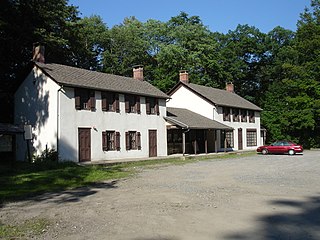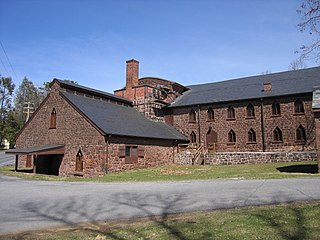Related Research Articles

Gaffney is a city in and the seat of Cherokee County, South Carolina, United States, in the Upstate region of South Carolina. Gaffney is known as the "Peach Capital of South Carolina". The population was 12,539 at the 2010 census, with an estimated population of 12,609 in 2019. It is the principal city of the Gaffney, South Carolina, Micropolitan Statistical Area, which includes all of Cherokee County and which is further included in the greater Greenville-Spartanburg-Anderson, South Carolina Combined Statistical Area.
Taylorstown is a small community in Loudoun County, Virginia, built on the banks of Catoctin Creek and the surrounding hillside, about two miles (3 km) south of the Potomac River. First settled in 1734, it holds two of the oldest standing houses in Loudoun County, "Hunting Hill" and "Foxton Cottage", directly across the Catoctin Creek from each other.

Long Pond Ironworks State Park is located in the community of Hewitt, in West Milford, New Jersey, United States. The park is known for its old stone walls, furnaces and other remnants of a once industrious ironworking community that now sits next to the swiftly flowing Wanaque River. The park is operated and maintained by the New Jersey Division of Parks and Forestry and has an area of 145 acres (0.59 km2).

Cornwall Iron Furnace is a designated National Historic Landmark that is administered by the Pennsylvania Historical and Museum Commission in Cornwall, Lebanon County, Pennsylvania in the United States. The furnace was a leading Pennsylvania iron producer from 1742 until it was shut down in 1883. The furnaces, support buildings and surrounding community have been preserved as a historical site and museum, providing a glimpse into Lebanon County's industrial past. The site is the only intact charcoal-burning iron blast furnace in its original plantation in the western hemisphere. Established by Peter Grubb in 1742, Cornwall Furnace was operated during the Revolution by his sons Curtis and Peter Jr. who were major arms providers to George Washington. Robert Coleman acquired Cornwall Furnace after the Revolution and became Pennsylvania's first millionaire. Ownership of the furnace and its surroundings was transferred to the Commonwealth of Pennsylvania in 1932.

Table Rock State Park is a 3,083-acre (12.48 km2) park at the edge of the Blue Ridge Mountains in northern Pickens County, South Carolina. The park includes Pinnacle Mountain, the tallest mountain totally within the state.

Cowpens Furnace Site (38CK73) is the remains of an early 19th-century iron-making furnace in Cherokee County, South Carolina. The site shows early American iron-making technology. The site was listed on the National Register of Historic Places in 1987.

The Swatara Furnace is a historic iron furnace and 200-acre national historic district located along Mill Creek, a tributary of the Swatara Creek in Pine Grove Township, Schuylkill County, Pennsylvania.

The Beckley Furnace Industrial Monument is a state-owned historic site preserving a 19th-century iron-making blast furnace on the north bank of the Blackberry River in the town of North Canaan, Connecticut. The site became a 12-acre (4.9 ha) state park in 1946; it was added to the National Register of Historic Places in 1978.

The Reading Furnace Historic District is a national historic district that is located in Warwick Township and East Nantmeal Township, Chester County, Pennsylvania.

Washington Iron Furnace is an historic iron furnace, located in Rocky Mount, Franklin County, Virginia. The granite furnace was built around 1770, and measures 30 feet high on its south face. It helped establish industry in the county, and was listed on the National Register of Historic Places in 1973.
Archeological Site 38CK1, also known as the Upton Site, is a historic archaeological site located near Gaffney, Cherokee County, South Carolina. The site contains well preserved examples of a specialized soapstone procurement site occupied primarily during the prehistoric, Late Archaic Period. The site is divided into two major areas and the quarry exhibits both historic and prehistoric utilization.
Archeological Site 38CK44, also known as Locus 1, is a historic archaeological site located near Gaffney, Cherokee County, South Carolina. The site contains well preserved examples of a specialized soapstone procurement site occupied primarily during the prehistoric, Late Archaic Period.
Archeological Site 38CK45, also known as Locus 2, is a historic archaeological site located near Gaffney, Cherokee County, South Carolina. The site contains well preserved examples of a specialized soapstone procurement site occupied primarily during the prehistoric, Late Archaic Period.
Coopersville Ironworks Site (38CK2) and Susan Furnace Site (38CK67), also known as the Cherokee Ford Ironworks Site and Nesbitt Iron Manufacturing Co., is a historic archaeological site located near Gaffney, Cherokee County, South Carolina. The site includes the foundations of four large factory buildings, with a system of canal/sluiceways between them, and the remains of three iron furnaces. The outlying furnace, Susan Furnace, includes foundations, sluiceways, slag heaps, and adjacent ore pits. The complex is the largest and best preserved factory complex of any of the 19th century iron manufacturing companies of the region. The complex was developed between 1835 and 1843 by the Nesbitt Iron Manufacturing Company, the largest iron company in South Carolina. The Nesbitt Company was dissolved in the late 1840s, and the Swedish Iron Manufacturing Company of South Carolina operated the ironworks from 1850 until the American Civil War.
Ellen Furnace Site (38CK68) is a historic archaeological site located near Gaffney, Cherokee County, South Carolina. The site includes a partially collapsed but well-preserved iron furnace constructed about 1838 of quarried stone and two earthen sluiceways. Also present are building foundations, tramway road beds, and ore mines. It is directly associated with the nearby Susan Furnace Site. Both were outlying furnace operations associated with the manufacturing complex at Coopersville owned by the Nesbitt Company and later the Swedish Ironworks. The Coopersville Ironworks along with the Susan and Ellen Furnaces were developed between 1835 and 1843 by the Nesbitt Iron Manufacturing Company, the largest iron company in South Carolina. The Nesbitt Company was dissolved in the late 1840s, and the Swedish Iron Manufacturing Company of South Carolina operated the ironworks from 1850 until the American Civil War.
Nesbitt's Limestone Quarry (38CK69) is a historic archaeological site located near Gaffney, Cherokee County, South Carolina. The site includes the most extensive and best preserved limestone quarry associated with early iron production in the northwestern Piedmont of South Carolina. It was the primary source of limestone for the region's ironworks. Quarrying activity at Nesbitt's ceased in the early part of the 20th century. The site covers approximately 30 acres and has exposed vertical faces of limestone and is located in a large body of limestone that extend in a linear fashion from Limestone College to across the South Carolina state line.
Thicketty Mountain Ore Pits (38CK74) is a historic archaeological site located near Shady Grove Church, Cherokee County, South Carolina. The site includes iron ore pits associated with the South Carolina Manufacturing Company, a major iron manufacturing company that operated in Spartanburg County between about 1825 and about 1850. The iron ore pits or surface mines cover several forested acres along a gently sloping ridge and are generally depressions about two to three meters deep and about five to ten meters across. The pits were last operational in the 1850s.

The Spikebuck Town Mound and Village Site is a prehistoric and historic archaeological site on Town Creek near its confluence with the Hiwassee River within the boundaries of present-day Hayesville, North Carolina. The site encompasses the former area of the Cherokee village of Quanassee and associated farmsteads. The village was centered on what is known as Spikebuck Mound, an earthwork platform mound, likely built about 1,000 CE by ancestral indigenous peoples during the South Appalachian Mississippian culture period.
Jackson's Furnace Site, also known as Stroup's Furnace, is a historic archaeological site located near Smyrna, York County, South Carolina. The site includes an earthen sluiceway, stone dam abutments, the stone foundation of an iron furnace and slag heaps. It is one of only two sites that can be associated with the King's Mountain Iron Company, which operated in present-day Cherokee County from about 1815 to about 1860. The other site is King's Creek Furnace Site in Cherokee County.
Kings Creek is an unincorporated community in Cherokee County, South Carolina, United States. It is located in the vicinity of South Carolina Highways 5 and 97. Situated nearby is the NRHP-designated King's Creek Furnace Site. The name of the community comes from a local settler named King who lived close to the locale on the namesake Kings Creek.
References
- 1 2 "National Register Information System". National Register of Historic Places . National Park Service. July 9, 2010.
- ↑ "King's Creek Furnace Site Cherokee County (Address Restricted)". National Register Properties in South Carolina. South Carolina Department of Archives and History. Retrieved February 25, 2014.
- ↑ unknown (n.d.). "King's Creek Furnace Site (38CK71)" (PDF). National Register of Historic Places nomination. NRHP. Retrieved February 25, 2014.

